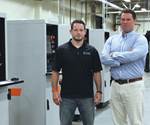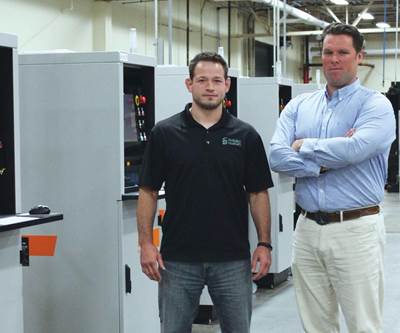Additive Manufacturing and 3D Printing Are Two Different Things
And as AM continues to advance, the differences are becoming more pronounced and more important.
Share
Read Next
It is time to confront a question at the heart of what this site is about and what we are interested in. Namely: Is additive manufacturing the same as 3D printing?
The answer is no. The two terms describe two different things. And the difference is becoming increasingly important—as recently posted articles show.
To be sure, the terms overlap. They can be used in ways that make them sound like synonyms. But the relationship between them and the difference between them is this: 3D printing is the operation at the heart of additive manufacturing, just as “turning” or “molding” might be the operation at the heart of a conventional manufacturing process. In short, additive manufacturing requires and includes 3D printing, but it also entails more than 3D printing, and it refers to something more rigorous.
With this site, our focus is manufacturing. The promise we see in additive technology is manufacturing. And seemingly with each new development in the additive space, that promise comes more clearly into view. Now, we are beginning to see companies committing to additive manufacturing so fully that they are ramping up entire facilities oriented around this method of making production parts.
Two examples recently featured are located on different continents. Our story on Tangible Solutions describes the questions and the hurdles a startup company faces as it aims to fully realize full-scale additive production. In this, 3D printing the component itself is arguably the most straightforward step. There is also the design of the support structures, the postprocessing operations and the considerations necessary to realize the process control sufficient for tight repeatability. Along with 3D printing, all of this is part of additive manufacturing as well.
Then there is the German company FIT, which is thinking about the promise to be found in the phase that comes next. If a facility can be set up to reliably and efficiently deliver contract manufacturing via AM, then couldn’t that very facility be reproduced in other regions to deliver short-lead-time production to customers in various places?
The FIT example in particular prompts another fundamental question about additive. Namely: Is the right way into AM by diversifying into it out of conventional manufacturing, or is the right way instead a clean-sheet approach involving a separate organization or separate company from conventional manufacturing teams?
(There are even shades of gray. Another company recently covered, Arizona Home Floors, became a manufacturer once it complemented outsourcing of conventional manufacturing with a commitment to in-house AM.)
Which of the two choices is the better way? I don’t know the answer. None of us do. We will find out over time, and maybe either choice—building off of conventional manufacturing or taking a focused approach to additive—represents an equally viable way in. For now, you can consider the question yourself. After reading the articles linked above about manufacturers taking a clean-sheet approach, read another recent story about a manufacturer that diversified into AM out of its success in machining. If one of these types of companies is able to succeed with the new approach to production more effectively than the other, then it might be that the business model is yet another element to consider in leveraging 3D printing into additive manufacturing.
Related Content
Implicit Modeling for Additive Manufacturing
Some software tools now use this modeling strategy as opposed to explicit methods of representing geometry. Here’s how it works, and why it matters for additive manufacturing.
Read More3D Printing with Plastic Pellets – What You Need to Know
A few 3D printers today are capable of working directly with resin pellets for feedstock. That brings extreme flexibility in material options, but also requires greater knowledge of how to best process any given resin. Here’s how FGF machine maker JuggerBot 3D addresses both the printing technology and the process know-how.
Read MoreCopper, New Metal Printing Processes, Upgrades Based on Software and More from Formnext 2023: AM Radio #46
Formnext 2023 showed that additive manufacturing may be maturing, but it is certainly not stagnant. In this episode, we dive into observations around technology enhancements, new processes and materials, robots, sustainability and more trends from the show.
Read MoreVideo: What Is Electron Beam Melting (EBM)?
Electron beam melting is the higher-energy metal 3D printing process offering advantages when it comes to productivity and thermal stresses. Here is an introduction to EBM.
Read MoreRead Next
Building an Additive Manufacturing Business for Production
What does it look like to build a business based on AM production from the ground up? An Ohio medical device contractor is finding out.
Read MoreBike Manufacturer Uses Additive Manufacturing to Create Lighter, More Complex, Customized Parts
Titanium bike frame manufacturer Hanglun Technology mixes precision casting with 3D printing to create bikes that offer increased speed and reduced turbulence during long-distance rides, offering a smoother, faster and more efficient cycling experience.
Read MoreAlquist 3D Looks Toward a Carbon-Sequestering Future with 3D Printed Infrastructure
The Colorado startup aims to reduce the carbon footprint of new buildings, homes and city infrastructure with robotic 3D printing and a specialized geopolymer material.
Read More


















